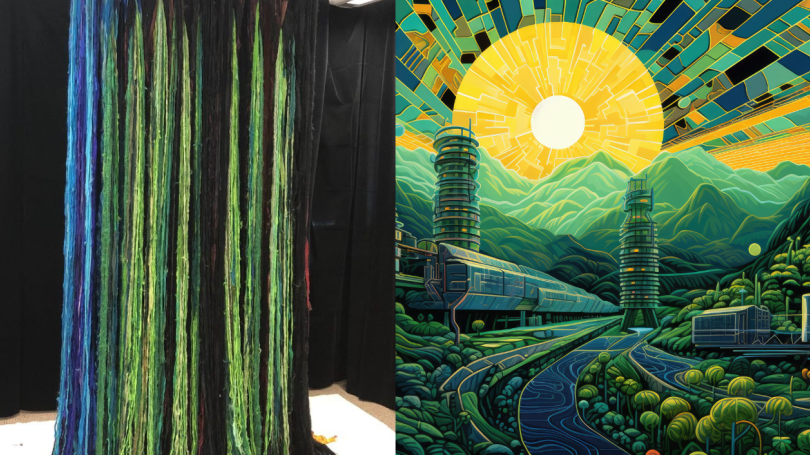
- About
- Education
- Research
- Engagement & Collaboration
- News & Events
Back to Top Nav
Back to Top Nav
Back to Top Nav
Back to Top Nav
Check out two new climate and energy related works, Energy Pools by Professor Jacque Wernimont and Solarscapes by Jeremy Hadfield '22, TH'23 in the Irving Institute.
The Arthur L. Irving Institute for Energy and Society currently has two Dartmouth community-designed installations, "Energy Pools" by Associate Professor of Film and Media Studies Jacqueline Wernimont, and "Solarscapes: Imagining Solarpunk Futures for Dartmouth," by Jeremy Hadfield '22, TH'23, on display in the building.
About Energy Pools
Hanging from the ceiling in the Irving Institute atrium, Energy Pools uses recycled or renewable textile strands to represent U.S. energy consumption in 2018. Embedded in the interior are an addition 400+ strands representing what we need to do to transform our energy supply to meet the IPCC goal of keeping anthropogenic global warming at +1.5 C by 2030. The piece invites the audience to pull the future into the present by braiding out the energy sources that we need to downscale and replace with renewable energy sources. Energy Pools places viewers in space with a large embodied tactile, touchable demonstration of energy sources in the United States, along with elements that allow viewers to explore the shifts that will need to be made for sustainable energy futures. Conceptualized and created by Professor Wernimont, along with technical assistance from Nikki Stevens and Caroline Casey, Energy Pools has been exhibited across the United States before coming home to Dartmouth.
About Solarscapes: Imagining Solarpunk Futures for Dartmouth
Solarpunk is an artistic movement that imagines positive sustainable futures where nature, technology, and community are inextricably intertwined. Solarpunk art and literature often envisions how a future world might look, operate and feel if humanity is able to successfully mitigate the global crises of climate change and environmental degradation. In his debut work Solarscapes, Jeremy Hadfield explores the imaginative landscape of solarpunk in the context of the Dartmouth campus. His images evoke a hopeful sense of harmony between humanity and nature, but also a sense of resistance and conflict. The piece blends optimism and critique — confronting Dartmouth's history of dependence on fossil fuels and its complex relationship with the environment while embracing the possibility of healing, regeneration, and abundance. Adding a layer to this work, the images were created with recent generative AI technology paired with older digital art methods. This medium can spark conversations about the implications of AI art, its ethics, and its potential for exploring latent spaces or imagining possibilities for the future. A Dartmouth '22, Jeremy studied Philosophy and Cognitive Science before embarking on a Masters of Engineering Management with a focus on AI and climate technology. This is his first public exhibition. The exhibit is commissioned by the Energy Justice Clinic and curated by Milanne Berg ('24) in collaboration with Dr. Sarah Kelly and Rachel Kent. Funding is provided by an Arts Integration Grant from the Hopkins Center for Arts.
Members of the Dartmouth community and public are invited to view both exhibit. The building is open to the public Monday-Friday, 7 a.m. - 4 p.m.